Fujian Tulou: Explore the Enigmatic Earthen Buildings of Southern China
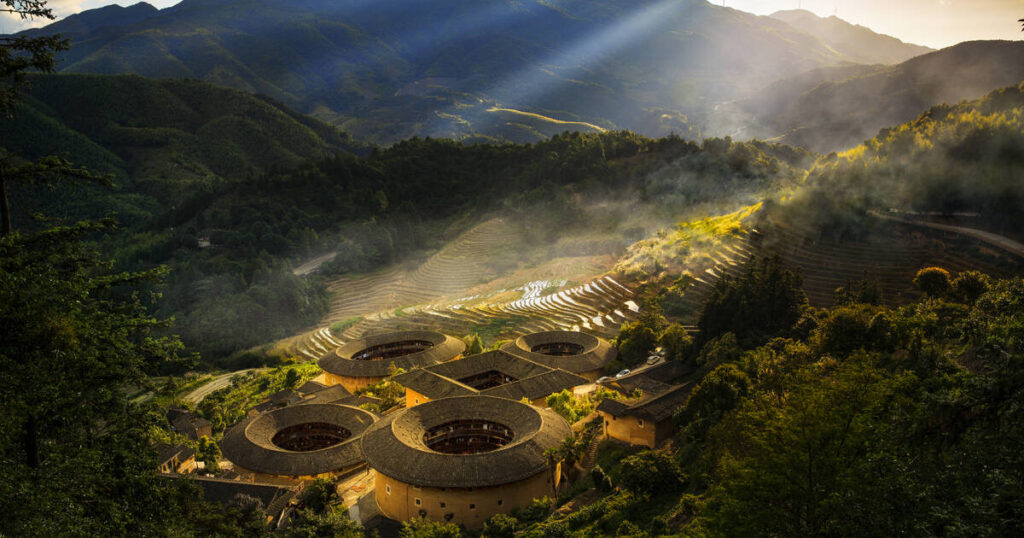
An Essential Guide to Visiting Fujian Tulou
Nestled amidst the lush, rolling hills of Fujian Province lies a remarkable architectural wonder that tells the story of resilience, community, and cultural heritage: the Fujian Tulou. These earthen structures, often described as “Hakka earth buildings,” are not just homes but living testaments to the ingenuity of the Hakka people, who have inhabited these unique dwellings for centuries. With their impressive circular and square designs, thick walls, and intricate layouts, tulous are a stunning blend of functionality and artistry, built to withstand the test of time and the elements.
Designated as a UNESCO World Heritage Site in 2008, the Fujian Tulou offers travelers a rare glimpse into a way of life that emphasizes family unity and collective living. Each tulou serves as a self-sufficient community, featuring everything from communal kitchens to ancestral halls, all centered around an inviting courtyard. As you wander through these ancient structures, you’ll be captivated not only by their architectural beauty but also by the rich tapestry of Hakka culture, from its delicious cuisine to its fascinating traditions.
Visiting the Fujian Tulou is more than just a sightseeing excursion; it’s an immersive experience in the heart of rural China. Surrounded by breathtaking natural landscapes, you can hike along scenic trails, taste authentic local dishes, and engage with the warm and welcoming Hakka community. Whether you’re a history buff, an architecture enthusiast, or simply seeking adventure, the Fujian Tulou promises a journey that will leave you inspired and enriched. Prepare to step back in time and explore a world where the past seamlessly intertwines with the present, offering you an unforgettable glimpse into a unique way of life.
In This Guide
- An Essential Guide to Visiting Fujian Tulou
- The Rich History and Legends of Fujian Tulou
- Main Highlights: What You Absolutely Can’t Miss
- Planning Your Visit: A Practical Guide
- Tickets: Prices, Booking, and Tips
- How to Get There: A Complete Transportation Guide
- Local Cuisine and Accommodation Nearby
- Frequently Asked Questions
- Final Thoughts on Your Trip
The Rich History and Legends of Fujian Tulou
Nestled in the mountainous regions of Fujian Province, the Fujian Tulou stands as a remarkable testament to the ingenuity and resilience of the Hakka people. These earth buildings, constructed primarily between the Song and Yuan Dynasties, serve not only as homes but as fortified communal structures that reflect a rich tapestry of history and tradition.
The origins of the Fujian Tulou can be traced back to the large-scale migrations of Han Chinese during periods of conflict and natural disasters in Northern China. As these migrants settled in the southwestern regions of Fujian, they faced the challenges of a rugged landscape. To adapt, they developed the tulou, using locally sourced materials such as earth, wood, stone, and bamboo. The earliest tulou were modest in size and simplicity but evolved significantly over centuries.
By the late Ming and Qing Dynasties, the construction of these earthen buildings reached a sophisticated level. The designs became more elaborate, featuring intricate layouts that combined defensive capabilities with communal living spaces. The circular and square configurations of the tulou not only provided structural integrity against invasions but also fostered a sense of community among families living under one roof. A single tulou could house dozens to hundreds of families, making them a focal point of social and cultural life for the Hakka people.
The architectural brilliance of the tulou is evident in their thick walls, which can measure up to two meters in thickness. These formidable structures are equipped with watchtowers and narrow entrances that enhance their defensive qualities, ensuring that residents could live safely in a time of uncertainty. The interior design is equally impressive, with central courtyards serving as communal hubs, surrounded by living quarters and functional spaces that catered to daily needs.
In 2008, the Fujian Tulou was designated as a UNESCO World Heritage Site, recognizing its outstanding architectural features and cultural significance. This designation has drawn visitors from around the globe, eager to experience the unique blend of history, architecture, and Hakka culture that these earthen buildings embody. Today, many of the tulou remain inhabited by local families, preserving traditions and lifestyles that have persisted for generations.
Legends surround the tulou as well, with stories passed down through the ages about the Hakka’s steadfast spirit and their communal bonds. These narratives, rich in lore, speak of resilience in times of hardship and the enduring legacy of a people who have thrived in harmony with their environment.
As you wander through the scenic landscapes dotted with these extraordinary structures, you can feel the pulse of history that echoes through the walls of the tulou. Each building tells its own story, a narrative woven into the very fabric of the Hakka culture, inviting travelers to step back in time and explore the depths of a rich heritage that continues to thrive in modern China.
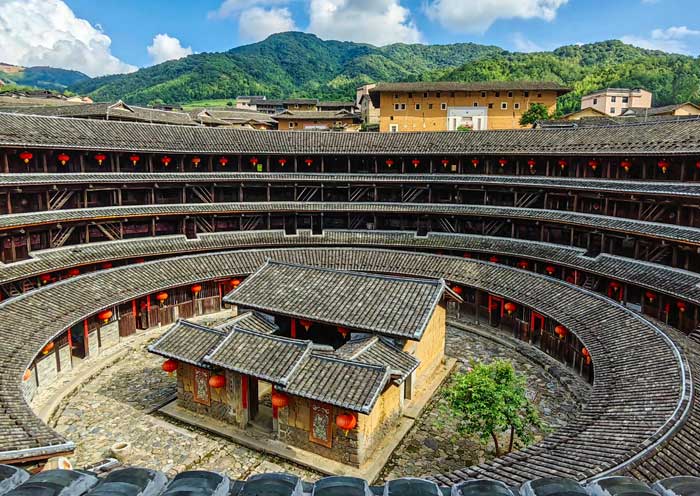
Fujian Tulou.
Main Highlights: What You Absolutely Can’t Miss
Exploring the Fujian Tulou is like stepping into a fascinating world where ancient architecture meets rich cultural heritage. Here are the main highlights you absolutely can’t miss during your visit to this UNESCO World Heritage site:
Iconic Tulou Clusters
- Hongkeng Tulou Cluster
-
Nestled in Hongkeng Village, this cluster boasts over 100 tulou houses, showcasing more than 30 unique shapes and architectural styles. Don’t miss the intricate designs of the palace-style and five-phoenix-style tulous, which offer a glimpse into the artistic ingenuity of the Hakka people.
-
Gaobei Tulou Cluster
-
Home to the Chengqi Lou, the largest tulou in the world, and Wuyun Lou, the oldest structure in Gaotou Town, this cluster is a must-see for architecture enthusiasts. The historical significance and grand scale of these buildings take you back to the Ming Dynasty.
-
Chuxi Tulou Cluster
-
Surrounded by serene mountains and rivers, the Chuxi cluster is perfect for those seeking tranquility. With its five circular tulous, this area offers stunning natural landscapes, making it ideal for photography and leisurely strolls.
-
Tianluokeng Tulou Cluster
-
Known for its unique “four dishes and a soup” layout, this cluster features four circular buildings arranged around a square. The view from the nearby observation platforms is breathtaking, providing a perfect perspective of this architectural marvel.
-
Taxia Village
- A hidden gem, Taxia Village is set against a picturesque backdrop of mountains and a flowing stream. Here, you’ll find 47 uniquely shaped tulous and the impressive dragon-carved stone pillars that stand as a testament to the village’s historical significance.
Cultural Immersion
- Hakka Cuisine
-
A visit to Fujian Tulou is incomplete without indulging in authentic Hakka dishes. Be sure to try the stuffed tofu and salt-baked chicken. Participating in a local tea-tasting session, particularly in Yunshuiyao, is another delightful way to connect with Hakka traditions.
-
Traditional Hakka Lifestyle
- Engage with locals to learn about their customs, clan systems, and folk music. The tulou houses are not just architectural wonders; they are living communities that reflect the resilience and unity of the Hakka people.
Scenic Adventures
- Hiking and Nature Walks
-
The lush landscapes surrounding the tulou clusters offer many hiking opportunities. Explore the ancient stone paths, trek to observation decks, or stroll along the scenic streams to fully appreciate the natural beauty of the area.
-
Photography Opportunities
- Fujian Tulou is a photographer’s paradise. Capture stunning aerial views of the tulou clusters, intricate carvings, and vibrant interiors. Early mornings or golden hours provide the best lighting for those perfect shots.
Unique Accommodations
- Stay Inside a Tulou
- For an immersive experience, consider staying overnight in one of the tulou houses. This unique opportunity allows you to live among the locals, gaining insight into their daily lives and traditions.
Visiting the Fujian Tulou is not just about witnessing remarkable architecture; it’s a journey into the heart of Hakka culture and an exploration of the stunning landscapes that surround these ancient dwellings. Whether you’re hiking through the hills, savoring traditional dishes, or capturing breathtaking photographs, each moment spent here will leave you with unforgettable memories.
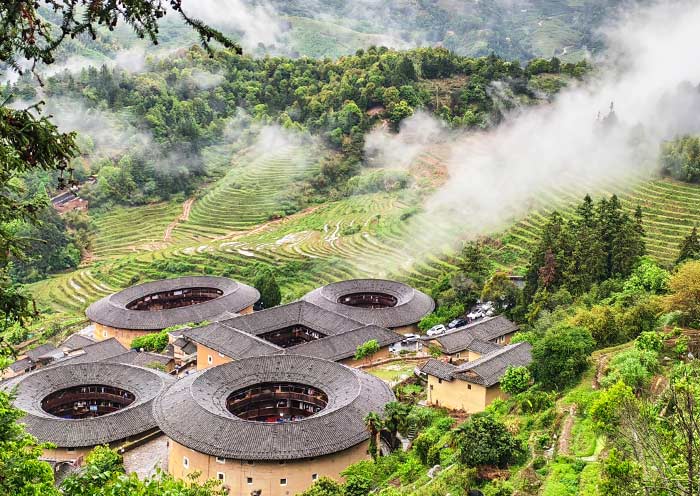
Fujian Tulou.
Planning Your Visit: A Practical Guide
Planning Your Visit: A Practical Guide to Fujian Tulou
Embarking on a journey to the Fujian Tulou region is not just about witnessing architectural wonders; it’s an immersive experience into the heart of Hakka culture and the stunning natural landscapes of China. Here’s everything you need to know to make the most of your visit.
Best Time to Visit
The ideal time to explore Fujian Tulou is during the spring (April to June) and autumn (September to November). During these months, the weather is mild and pleasant, perfect for hiking and outdoor photography, while the surrounding landscapes boast vibrant colors. Avoid the rainy season (July to August) if possible, as heavy rainfall can hinder travel plans and outdoor activities.
Getting There
By Air: The nearest major airport is Xiamen Gaoqi International Airport (XMN), which offers numerous international and domestic flights. From Xiamen, you can take a bus or hire a car to reach the tulou areas, which are approximately 2 to 3 hours away.
By Train: For travelers already in China, high-speed trains to Longyan or Zhangzhou are available from major cities. Once you arrive, local buses or taxis can take you to the tulou clusters.
By Bus: Regular bus services operate from Xiamen to Yongding and Nanjing Counties, making it a convenient option for budget travelers.
Local Transportation
Once you’re in the tulou area, consider renting a bicycle or hiring a local driver to explore the clusters at your own pace. Many towns have well-marked trails, making it easy for visitors to navigate between the various tulou sites.
Where to Stay
Staying in a tulou offers a unique and authentic experience. Many of the earthen buildings have been converted into guesthouses where you can enjoy local hospitality and cuisine. Here are some options:
-
Inside a Tulou: Experience the true essence of Hakka life by staying overnight in one of the tulou guesthouses. This allows you to immerse yourself in the culture and enjoy the tranquility of rural life.
-
Nearby Hotels: If you prefer more conventional accommodations, several hotels are located in nearby towns like Yongding and Nanjing, offering modern amenities and easy access to tulou sites.
What to Bring
-
Comfortable Footwear: Prepare for walking and hiking with sturdy shoes. The terrain can be uneven, especially around the tulou clusters.
-
Camera: Capture the stunning architecture and picturesque landscapes. Early mornings and late afternoons provide the best lighting for photography.
-
Cash: While larger towns may accept credit cards, smaller villages and local vendors often only accept cash.
-
Local SIM Card or Portable Wi-Fi: For easy navigation and communication, consider getting a local SIM card or renting a portable Wi-Fi device.
Activities to Enjoy
-
Hiking and Walking: Explore the beautiful countryside with scenic hikes around the tulou areas. Popular trails lead to observation platforms with breathtaking views of the clusters and surrounding landscapes.
-
Photography: Take advantage of the unique architecture and stunning backdrops. Consider visiting at sunrise or sunset for the best lighting.
-
Cultural Immersion: Engage with the Hakka community by tasting local dishes, participating in tea ceremonies, or learning about their traditions and history.
-
Guided Tours: Consider joining a guided tour to gain deeper insights into the history and cultural significance of the tulou. Local guides can provide valuable context and stories that enhance your experience.
Useful Tips
-
Language: While Mandarin is the official language, many locals may not speak English fluently. Learning a few basic Mandarin phrases can enhance your interactions.
-
Respect Local Customs: Hakka communities are proud of their heritage. Be respectful of their traditions and customs, especially when taking photographs.
-
Plan Ahead: Some tulou can get crowded during peak tourist seasons. Consider visiting lesser-known clusters for a more tranquil experience.
Conclusion
Visiting Fujian Tulou is an unforgettable journey into a unique architectural and cultural landscape. With its rich history, stunning natural beauty, and opportunities for immersive experiences, it’s a destination that promises to leave a lasting impression. Plan your visit with this guide in hand, and prepare for a remarkable adventure in the heart of Hakka culture.
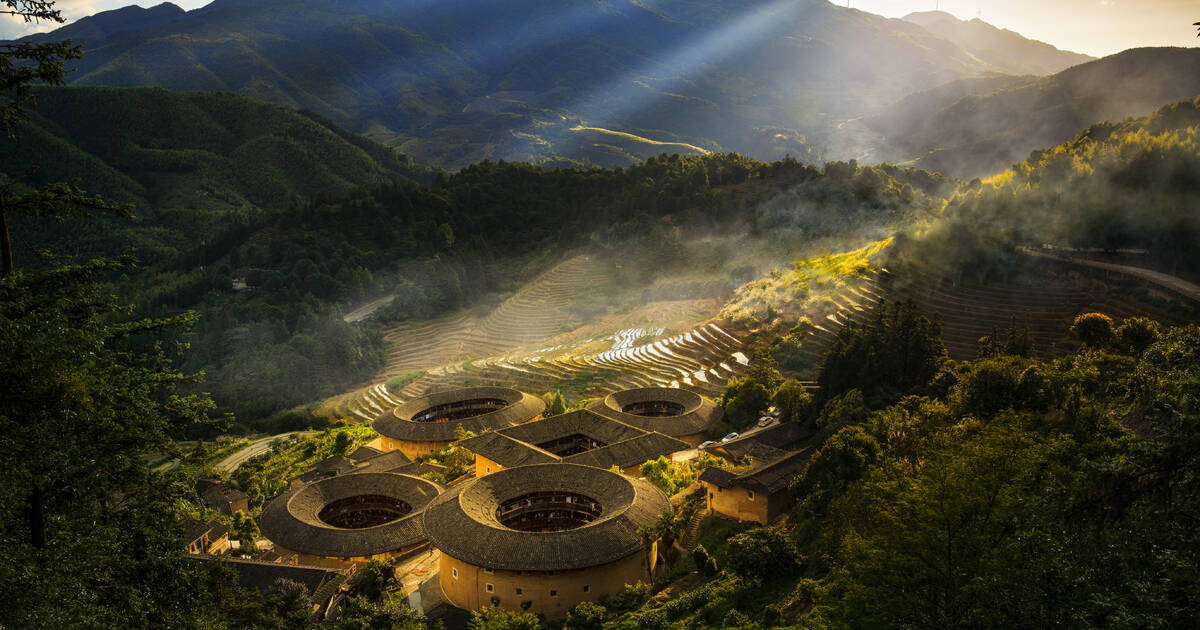
Fujian Tulou.
Tickets: Prices, Booking, and Tips
When planning your visit to the captivating Fujian Tulou, understanding ticket prices, booking options, and handy tips can enhance your experience significantly. Here’s everything you need to know to navigate your journey through these unique earth buildings.
Ticket Prices
Entry fees to the various tulou clusters can vary, but generally, you can expect to pay around ¥50 to ¥100 (approximately $7 to $14 USD) per person for a ticket to a specific cluster. Some popular clusters, such as the Tianluokeng Tulou Cluster, may charge a slightly higher fee, especially during peak tourist seasons. It’s worth noting that many clusters have different pricing for adults, children, and seniors, so be sure to check specific details when you arrive.
Booking Tickets
Most tickets can be purchased on-site at the entrance of each tulou cluster. However, during peak travel seasons—like Chinese New Year or summer holidays—it’s advisable to arrive early to avoid long lines.
For those looking for a more streamlined experience, consider booking a guided tour that includes tulou visits in your itinerary. Many travel agencies and online platforms offer comprehensive packages that cover transportation, entrance fees, and guided tours of the most iconic tulou clusters. This option can be especially beneficial for international travelers who may prefer the convenience of a structured plan.
Tips for Visiting Fujian Tulou
-
Timing Your Visit: The best time to explore the Fujian Tulou is during the spring (April to June) and autumn (September to November) when the weather is mild and the landscapes are particularly beautiful. Early mornings and late afternoons provide excellent lighting for photography, so plan your visit accordingly.
-
Exploring Multiple Clusters: If your schedule allows, consider visiting both Yongding and Nanjing counties. Each area offers distinct architectural styles and cultural experiences, making for a richer understanding of Hakka culture.
-
Wear Comfortable Footwear: The terrain around the tulou clusters can be uneven and hilly. Comfortable shoes are essential for exploring the villages and hiking the scenic trails that lead to stunning viewpoints.
-
Engage with Locals: Don’t miss the opportunity to interact with the Hakka residents. Many are eager to share their culture, stories, and traditional cuisine. Participating in local activities can greatly enhance your experience.
-
Photography Etiquette: While photography is encouraged, always be respectful of local customs and individuals. If you wish to photograph people, ask for their permission first.
-
Check Local Regulations: Before your visit, check for any updated visitor information or regulations, especially if you plan to use a drone for aerial shots. Certain areas may have restrictions in place.
By equipping yourself with this essential information, your visit to the Fujian Tulou will be both enjoyable and memorable, allowing you to fully appreciate the architectural marvels and rich heritage of the Hakka people. Happy travels!
How to Get There: A Complete Transportation Guide
To experience the breathtaking Fujian Tulou, finding the right transportation options is key to unlocking the wonders of these magnificent earth buildings. Whether you’re arriving from a major city or exploring the surrounding areas, this guide will help you navigate your journey to these UNESCO World Heritage sites with ease.
Getting to Fujian Tulou
By Air
The nearest major airport to the Fujian Tulou is Xiamen Gaoqi International Airport (XMN), located approximately 200 kilometers from Yongding County, the heart of tulou architecture. Here’s how to continue your journey:
- From Xiamen Airport to Yongding:
- Bus: Take a long-distance bus from Xiamen to Yongding. The journey takes about 3-4 hours, and buses run frequently throughout the day. Look for buses at the Xiamen North Station or directly from the airport.
-
Private Transfer: For convenience, consider booking a private car service or taxi, which can take you directly to your destination in Yongding or Nanjing County.
-
Alternative Airport:
- Fuzhou Changle International Airport (FOC) is another option, located about 250 kilometers from the tulou area. Similar transport options are available from here.
By Train
Traveling by train can be a scenic and comfortable way to reach the Fujian Tulou region:
- From Xiamen:
- Take a high-speed train from Xiamen to Longyan, which takes around 1.5 hours. Longyan is the nearest city with train access to the tulou.
-
From Longyan, you can catch a bus or hire a taxi to Yongding County, approximately 1 hour away.
-
From Fuzhou:
- High-speed trains from Fuzhou to Longyan are also available, taking about 2 hours. Follow the same transfer method as above.
By Bus
If you’re already in the region, traveling by bus can be a straightforward option:
- Local Buses: Yongding and Nanjing Counties are well-connected by local buses. Frequent services run from major cities like Xiamen, Longyan, and Fuzhou. Check the local bus stations for schedules and ticket prices.
Getting Around Fujian Tulou
Once you arrive in the Fujian Tulou area, exploring the scenic landscapes and tulou clusters can be done in several ways:
- Guided Tours:
-
Opt for a guided tour that includes transportation. Many local operators offer packages that cover multiple tulou clusters, making your exploration hassle-free.
-
Public Transport:
-
Local buses and minibuses connect various tulou clusters. However, services may be limited, so be sure to check schedules in advance.
-
Bicycle Rentals:
-
Some areas offer bicycle rentals, providing a leisurely way to explore the picturesque countryside and nearby tulou complexes.
-
Walking:
- The best way to truly appreciate the beauty of the tulou and surrounding landscapes is on foot. Many clusters are within walking distance from one another, and you can enjoy the fresh air and rural scenery.
Tips for a Smooth Journey
- Language: While Mandarin is the official language, English may not be widely spoken in rural areas. Learning a few basic phrases or using translation apps can be helpful.
- Cash: While larger towns may accept cards, many rural areas and local vendors prefer cash. Ensure you have enough local currency on hand.
- Timing: Plan your trip during daylight hours to maximize your exploration. The tulou are particularly stunning during sunrise and sunset.
By following this transportation guide, you’ll be well on your way to uncovering the enchanting world of Fujian Tulou, where history, culture, and stunning architecture await. Safe travels!
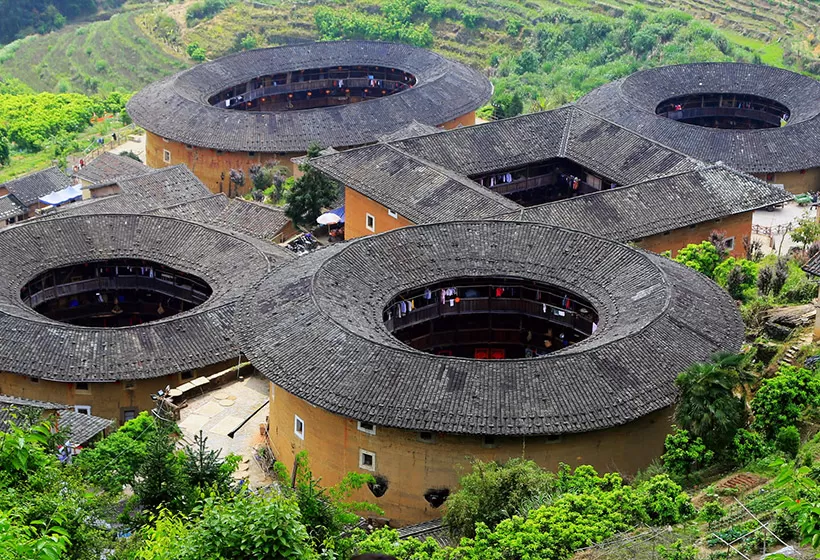
Fujian Tulou.
Local Cuisine and Accommodation Nearby
When exploring the fascinating world of Fujian Tulou, indulging in local cuisine and finding the right accommodation can significantly enhance your experience. The region is rich in flavors and offers a variety of unique dining options, along with accommodations that allow you to immerse yourself in the Hakka culture.
Culinary Delights
- Hakka Cuisine: A visit to Fujian Tulou wouldn’t be complete without sampling authentic Hakka dishes. Look for local eateries serving:
- Stuffed Tofu (豆腐干): Soft tofu filled with a savory mix of minced meat and spices, often steamed or fried to perfection.
- Salt-Baked Chicken (盐焗鸡): A specialty that sees chicken marinated and baked in a salt crust, yielding tender, flavorful meat.
-
Hakka Noodles (客家面): These are hearty noodles, often served stir-fried with seasonal vegetables and your choice of meat.
-
Local Snacks: Don’t miss out on street vendors offering delicious snacks such as:
- Sweet Potato Balls (地瓜球): Crispy on the outside and soft on the inside, these are a delightful treat.
-
Rice Cakes (米糕): Often filled with various ingredients like pork or vegetables, these fluffy cakes are a must-try.
-
Tea Culture: Engage in a traditional tea ceremony at local tea houses. Fujian is known for its high-quality oolong teas, particularly in Yunshuiyao Village, where you can also enjoy beautiful views while sipping your brew.
Places to Stay
For an authentic Hakka experience, consider these accommodations:
- Stay in a Tulou: Many of the tulou buildings offer basic lodging options, allowing you to sleep in these historic structures. Notable mentions include:
- Chengqi Lou: Known as the largest tulou, it provides a unique experience with rooms that reflect traditional Hakka living.
-
Zhencheng Lou: This well-preserved tulou offers comfortable guest rooms and the chance to immerse yourself in the local community.
-
Guesthouses and Homestays: If you prefer more amenities while still experiencing local culture, look for guesthouses and homestays in nearby villages. Options like:
- Hongkeng Tulou Guesthouse: Located close to the Hongkeng Tulou Cluster, this guesthouse offers cozy rooms and home-cooked meals.
-
Taxia Village Homestay: Set within the scenic Taxia Village, this homestay provides a tranquil environment and local culinary experiences.
-
Hotels in Nearby Towns: For travelers seeking modern comforts, consider hotels in Yongding or Nanjing County. Options like:
- Fujian Tulou Hotel: A contemporary hotel that combines comfort with easy access to tulou clusters.
- Nanjing Tulou Resort: Offers modern amenities and guided tours to nearby tulou sites.
Conclusion
Whether you are savoring the rich flavors of Hakka cuisine or resting in the heart of a tulou, your journey through Fujian will be filled with memorable experiences. Embrace the local culture, indulge in the culinary delights, and enjoy the unique accommodations that this remarkable region has to offer.
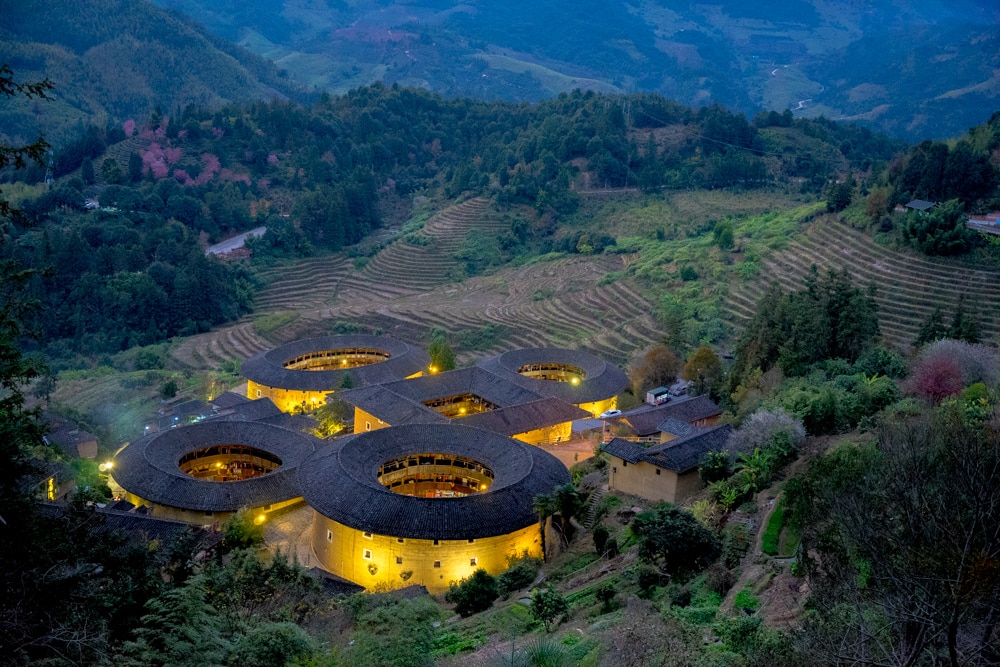
Fujian Tulou.
Frequently Asked Questions
-
What are Fujian Tulou, and why are they significant?
Fujian Tulou, also known as Hakka Tulou, are traditional earthen buildings constructed by the Hakka people in Fujian Province. These unique structures, recognized as a UNESCO World Heritage Site, showcase impressive architectural ingenuity and rich cultural heritage, making them a must-visit for travelers interested in history and architecture. -
When is the best time to visit Fujian Tulou?
The optimal time to visit is during spring (March to May) and autumn (September to November) when the weather is mild and pleasant. This timeframe also offers stunning natural scenery, with blooming flowers in spring and colorful foliage in autumn. -
How can I get to Fujian Tulou from Xiamen?
Fujian Tulou is easily accessible from Xiamen. You can take a train or a bus to Yongding or Nanjing County, which are the main areas where tulou clusters are located. The journey typically takes around 2-3 hours, making it perfect for a day trip or extended stay. -
Are there guided tours available for Fujian Tulou?
Yes, there are various guided tours available that can enhance your experience. These tours often include transportation, knowledgeable guides, and cultural activities, allowing you to explore the tulou clusters and learn about Hakka culture in depth. -
What should I wear when visiting Fujian Tulou?
Dress comfortably and wear sturdy shoes, especially if you plan on hiking or walking around the tulou clusters. The terrain can be uneven, so appropriate footwear will help you navigate the area safely. Additionally, layers are advisable since temperatures can vary throughout the day. -
Can I stay overnight in a Fujian Tulou?
Absolutely! Many tulou houses offer accommodations for travelers. Staying overnight allows you to immerse yourself in local Hakka culture, experience daily life in a tulou, and enjoy the serene countryside atmosphere. -
What activities can I enjoy while visiting the Fujian Tulou?
Beyond exploring the impressive architecture, visitors can hike through picturesque landscapes, participate in local tea tastings, try authentic Hakka cuisine, and immerse themselves in Hakka traditions and music. Don’t forget your camera; the scenery is perfect for photography! -
Is it possible to take drone photos in the Fujian Tulou area?
Drone photography is generally permitted, but it’s important to check for any local restrictions or guidelines before flying. Early morning or late afternoon is the best time for capturing stunning aerial views of the tulou and surrounding landscapes.
Final Thoughts on Your Trip
As your journey through the enchanting landscape of Fujian Tulou comes to a close, you’ll find yourself enriched not only by the stunning architecture but also by the deep-rooted culture that envelops these extraordinary earthen structures. Each tulou tells a story—a testament to the resilience and creativity of the Hakka people who crafted these remarkable dwellings, harmonizing their living spaces with the breathtaking natural surroundings.
Embrace the memories of wandering through the winding paths of Taxia Village, savoring the unique flavors of Hakka cuisine, and capturing the timeless beauty of these UNESCO World Heritage sites. Whether you marveled at the intricate designs of circular and square tulous or engaged with local traditions, the experiences gained here will linger long after you’ve returned home.
Fujian Tulou isn’t just a destination; it’s an invitation to connect with history, nature, and the warmth of a community that continues to thrive within its earthen walls. So, as you pack your bags and prepare to leave this captivating region, carry with you the spirit of the tulou and the stories of its people—a true reflection of a rich cultural tapestry that awaits your return.